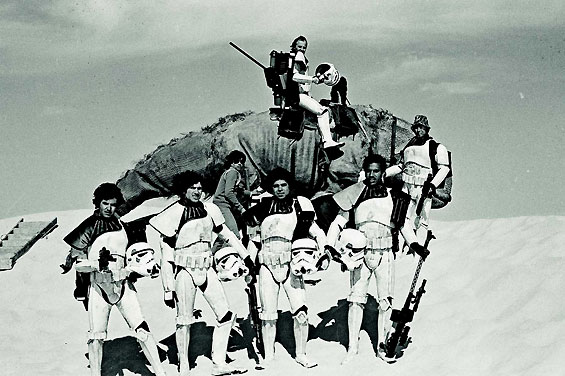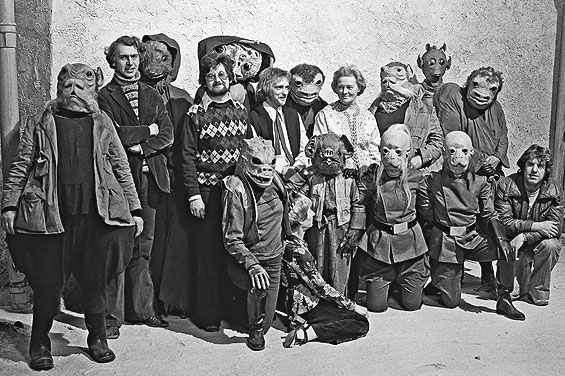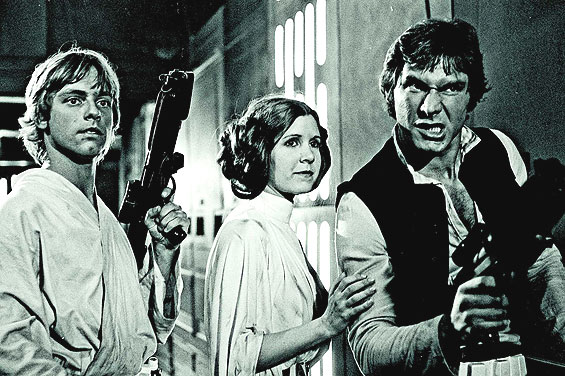I can’t believe how much work I have to do right now. It’s sort of amazing. I’m not stressed anymore; I’ve passed into a state of constant bemusement by now. There is not an hour of my day right now that’s not accounted for. And even so, there are certain things that leapfrog right past everything else in terms of priority.
Such was the case with THE MAKING OF STAR WARS for me over the last few days. The book actually showed up here at the house about two weeks ago, and I started flipping through it right away. It’s a great cover:

And honestly, when I got it, I thought it would be one of those STAR WARS books you can flip through and dip in and out of and just keep as occasional reference/fanboy porn. For example, I was given a gift recently that was sort of amazing, a giant 20 pound red box with inlaid pieces of the Millennium Falcon on the cover. It’s some super-deluxe version of a package called SCULPTING A GALAXY: INSIDE THE STAR WARS MODEL SHOP, and it’s filled with some pretty cool photos for the hardcore FX geek side of me. It’s a good book. Not a great book. But the package overall sort of makes up for it. That’s more than a coffee-table book; that’s full-blown nerd furniture.

But this book by J.W. Rinzler... wow. This is a book I’ve always wanted, but I never realized I was missing it until I started reading. This was supposed to be published in connection to the release of the first STAR WARS back in 1977. It was a project spearheaded by Charles Lippincott, a v.p. of merchandising and publicity for 20th Century Fox. He conducted exhaustive interviews, many of them before the film ever opened.
If you’re a life-long STAR WARS fan, you know that the story of how that first film was made is almost a myth unto itself now, and there are all sorts of legends that have been embellished, many of which were no doubt encouraged by Lucas himself. Here... finally... is an impeccably written and researched look at the way it really happened, removed of all myth-making, step by arduous step.
This is a book that George Lucas lovers and haters alike will offer as proof of everything they feel about him, and that’s the way it should be. This is an unbiased picture, or as much of one as is possible. Rinzler obviously loves the STAR WARS films, but he doesn’t write as a gushing fan. He writes with a clear eye, and he knows how to tell the story. It’s engaging, detailed, very entertaining. This is, aside from its value to me as a piece of STAR WARS history, a really well-written book, and that is almost unheard of in the behind-the-scenes publishing world. Most making-of books are interesting primarily if you’re a film geek and you want to know more. Sometimes, they are something greater, and I’ve noticed that most of the ones that eventually win acclaim are for disastrous productions. It’s rare that you get a picture of the controlled chaos that goes into also creating a classic, a movie that connects with people on a chemical level. When you look at the chain of events and decisions that it took for STAR WARS to become STAR WARS, it is a potent lesson of the one thing I know to be absolutely, unquestionably true about Hollywood: it is a goddamn miracle that anyone ever makes any films that are worth watching at all. There are a million ways for a film to not work, but it seems like for the great movies, here is only one way it could possibly have worked.
This book would make a great companion piece to Laurent Bouzereau’s THE ANNOTATED SCREENPLAY, which is an awesome reference source, but not as much of a great read on its own. Bouzereau is preaching to the converted; Rinzler’s book traces the process by which the film managed to convert anyone in the first place. The book starts with an introduction by Peter Jackson that speaks directly to a generation that was driven movie-crazy by their first exposure to STAR WARS. Then there’s a brief description by Rinzler of just how he came across the Lippincott interviews while he was working on the making-of book for REVENGE OF THE SITH.
Among those who were interviewed by Lippincott were Gary Kurtz, George Lucas, Alan Dean Foster, John Dykstra, Gilbert Taylor, Robert Watts, Stuart Freeborn, John Stears, John Barry, Carrie Fisher, Mark Hamill, Harrison Ford, Anthony Daniels, John Williams, Paul Hirsch, Joe Johnston, Ben Burtt, Ralph McQuarrie, Marcia Lucas, Alan Ladd Jr., Richard Edlund, Harrison Ellenshaw, Dennis Muren, and more. The book starts tracing the development of the idea in 1968, and chapter one goes all the way through 1973. The really heavy lifting, where Lucas first cracked the piece, takes place in chapter two, from August 1973 to January 1975. In a sense, this is the most creative Lucas has ever been regarding the series. During that time, he was just writing and writing and writing, trying to figure out what story he was telling and what characters he wanted to use.
That vision starts to come into focus in chapter three, between January and August of 1975, when Lucas meets Ralph McQuarrie, whose paintings are such a major part of the look and feel of the STAR WARS universe. He was actually doing some concept art for Hal Barwood and Matthew Robbins for a SF film they never ended up making, and Lucas saw the art and hired him. What I love in these early chapters is watching how the creative team fell together. Each of these people had to contribute some part to the picture that was starting to come together, and with each person who understood what Lucas was talking about, STAR WARS inched its way towards reality. Chapter Five, “Purgatory,” traces the period from September to December 1975, when Fox put the entire project on hold because they had yet to finish contract negotiations and they were no longer willing to spend any money until they could vote on whether or not they were going to make the film. LUCKY LADY, an expensive bomb by Stanley Donen, almost hobbled the film because Fox lost money on that, and the production model for STAR WARS was much the same, with an independently-minded director and a potentially-expensive movie that seemed to get more expensive every day.
The book details the way money was spent on the film, and the numbers seem scrupulously honest. It’s amazing to read how (relatively) little they spent on this film when you consider how ground-breaking it was. It may have seemed like a huge gamble at the time, but even adjusting for inflation, it seems to me like it was a fairly responsible budget for a film of this kind of ambition.
There have been so many stories told about the casting of the film that I assumed I’d heard them all. But again... this is all information that was fresh when Lippincott did these interviews, so there are things here that I assume have just been forgotten or ignored in the years since. I’m fascinated by the various ways Lucas considered putting his cast together. At one point, he wanted Toshiro Mifune to play Obi-Wan in Japanese, with subtitles, and he was going to cast the Princess as Japanese, too. If he did that, though, he wanted a black Han Solo, and at one point, Laurence Hilton-Jacobs (Freddie “Boom Boom” Washington from WELCOME BACK KOTTER) was the front-runner.





Drew McWeeny, Los Angeles







Drew McWeeny, Los Angeles
